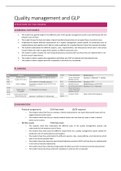Samenvatting
Full summary of the course Quality Management and GLP
This documents includes a full summary of the course Quality Management and GLP with class notes. Contains all classes! Note: only on the class of 4/10 (Claudina- GLP part 1) no class notes are added since no recording of this class was provided. However all Powerpoint notes are also included!
[Meer zien]



